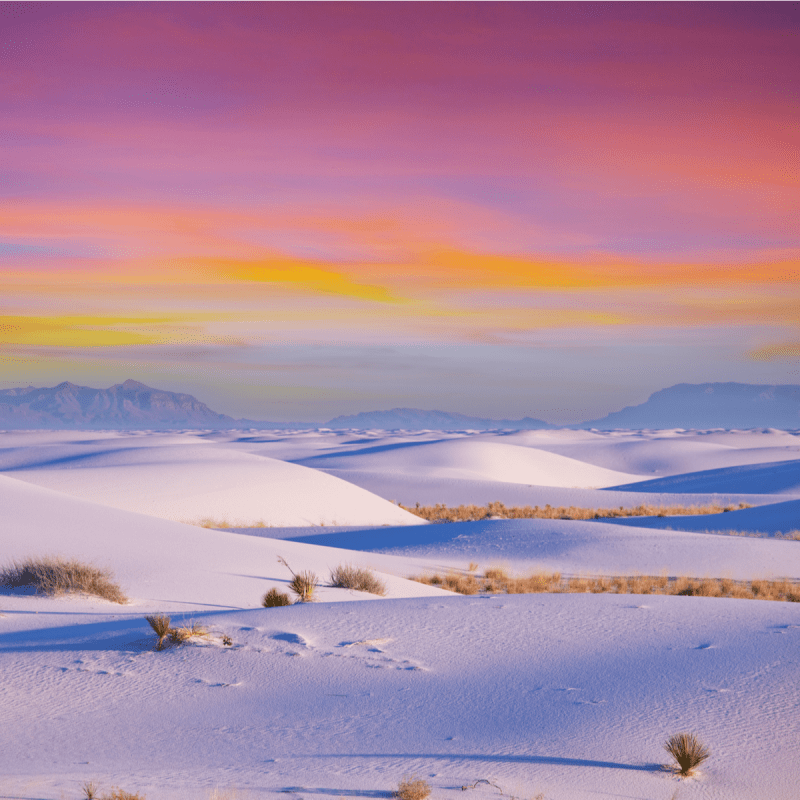
Think white sandy beach, but no ocean. Remote camping, crystal fields of gypsum, rainbow sunsets, unique desert plants, and wildlife are all protected by these state and national parks, with one thing in common, sand dunes. Hike, surf the dunes, or ride an off-road vehicle where allowed. Now is the time to visit when winter temperatures are manageable, and crowds are sparse. Here is my pick of eight sand dune parks to explore from Texas across the western United States.
Videos by TravelAwaits

1. Texas: Monahans Sandhills State Park
The soft dunes of Monahans Sandhills State Park will fill your shoes with sand as your feet sink ankle-deep or more in the 4,000-acre sandbox in West Texas. The State Park, near the town of Monahans, is a mile and a half west of Interstate 20, halfway between Odessa and Pecos. You might think you’re in the Sahara Desert, with 70-foot-tall dunes, except for the oil pumpjack looming near some picnic tables, now offline and fenced in for safety. As it turns out, the pumpjack comes in handy as a navigational landmark.
You enter the park through 40,000 acres of shin oak, knee-high oaks that help stabilize the sandy dunes with roots that reach down 25 feet or more. Would you believe these 20-inch-tall oaks form one of the most extensive oak forests in the United States? Visit the Dunagan Visitor Center to learn about the wildlife, birds, and plants in the area and rent sand disks to surf the dunes. To guarantee entrance, make a reservation online for passes, or call the visitor center before your visit.
Bring a lunch and eat at one of the shaded picnic tables, or reserve one of 26 campsites with water and electricity for overnight camping. The busy season is March through August when the sand is hot, and the spring break and summer crowds make vying for a shady spot a contest. Come during the wintertime for sunny days and cold nights when a campfire feels good. You’ll find fewer crowds and access to camping spots easier to come by. The sunsets here are spectacular. Pets on a leash can explore the park with you.
Pro Tip: For the best barbecue in West Texas, don’t miss Pappy’s Bar-B-Q in Monahans with tasty mesquite-smoked meats that have made Texas Monthly’s list of top 50 barbecue restaurants in Texas. Get there early as some items sell out.

2. New Mexico: White Sands National Park
White Sands National Park in Tularosa Basin in southeast New Mexico covers 145,762 acres or a 275-square-mile gypsum crystal field of white dunes — the world’s largest. To get there, drive 15 miles southwest of Alamogordo on US Highway 70 to the Visitor Center, or 52 miles northeast from Las Cruces.
Explore an 8-mile (16-mile round trip) scenic Dunes Drive from the visitor center offering picnic areas, parking areas for five hiking trails and exhibits, plus vault toilets. Bring a lunch and plenty of water to picnic at one of 62 shaded tables. Buy a snow-saucer at the park gift shop for dunes sledding. Back-country tent camping is currently closed. There is no overnight RV camping available.
You’ll see the most magnificent sunsets here, with the sky changing from golden to rose to violet. Join the Sunset Stroll, one of several Park Ranger events, where you hike through the dunes with a ranger and learn about earth science, desert plants, and wildlife. Time it right and take a Full Moon Hike with a ranger the night before the full moon from April through December.
Hike the 3-hour guided Lake Lucero Tour to learn how the dunes formed. You’ll see thousands of selenite crystals 1 to 2 feet long on a dry lakebed. This fantastic hike is offered monthly from January through March, requiring ticketed reservations.
Winter weather averages 60-degree-Fahrenheit days and nights below freezing, while spring and fall offer moderate temperatures. The summertime is best early in the morning or near sundown since days can reach 110 degrees.
Pro Tip: Check ahead for open hours, as sometimes the park is closed for missile testing at the nearby White Sands Missile Range.

3. Oklahoma: Little Sahara State Park
Northwest of Oklahoma City, and four miles south of Waynoka, Oklahoma, Little Sahara State Park, known as America’s Sandbox, offers more than 1,600 acres of dunes varying from 25 to 75 feet in height. The main attraction here is dune buggy and ATV riding; bring your own ATV or rent one from a vendor offsite. See the safety regulations requiring a helmet, roll bar, 10-foot whip, safety flags, and vehicle lights. Dune buggies are a blast but ride at your own risk.
The park offers three campgrounds with 214 RV sites with electricity and water, 83 tent sites, picnic areas, three covered shelter areas, and showers. You can reserve the campsites online. Climb the nearby observation deck, see gorgeous views, and learn area history.
Pro Tip: Have an authentic German dinner in Waynoka at Café Bahnhof, offering bratwurst, schnitzel, beef roulade, and ice-cold German beer.

4. Colorado: Great Sand Dunes National Park And Preserve
We could spend a week in south-central Colorado near Alamosa and not see all the Great Sand Dunes National Park and Preserve offers. You’ll see ecosystems ranging from the tallest dunes in North America to forest, wetland, and tundra at the 107,342-acre (167.7 square miles) park. Be sure to see the visitor center for the park film, exhibits, and park store. You can sand surf the hills from the main dunes parking area and visit Medano Creek, a seasonal creek sourced from snow runoff.
Have lunch at one of three picnic areas and hike Montville Nature Trail. Find a beautiful view of the dunes and an exhilarating waterfall at Zapata Falls Recreational Area. See grazing elk, mule deer, or pronghorn in the grasslands toward the entrance road at sunrise or sunset. Avoid the midday summer sand temps that can get to 150 degrees.
Pinon Flats Campground is 1 mile north of the visitor center, open April through October. All sites must be reserved on recreation.gov and are available up to 1 year in advance. Campsites can accommodate RVs up to 33 feet or trailers 20 feet long. Individual campsites can have eight people, two tents, and two vehicles.
A seasonal camp store sells firewood, ice, and camping goods. Well-behaved pets are welcome on a leash. Access the Oasis Campground, a private campground outside the park entrance for larger RVs.
Pro Tip: Use bear-proof lockers at each site since bears frequent the campground area.

5. California: Dumont Dunes
Located 31 miles north of Baker, California, between steep volcanic hills and the Amargosa River, the 8,150-acre Dumont Dunes is an area of the Mojave Desert between Los Angeles and Las Vegas.
ATV riding is allowed at Comp Hill and Banshee Hill. Temperatures soar over 110 degrees here in the summer, so the primary riding season is the winter and shoulder seasons. Camping with a pass to access the dunes is allowed, but there’s no official campground, just a place to pull up and set up with no shade. Out-of-state ATVs require a nonresident Off-Highway Vehicle Use Permit. There are pit toilets but no water or amenities.
Pro Tip: Baker hosts the closest restaurants and facilities 30 miles away.

6. California: Mesquite Flat Sand Dunes, Death Valley National Park
The dunes in Death Valley National Park are protected wilderness, with no off-road vehicle travel permitted. The Mesquite Flat Dunes are the easiest to visit in the park near Stovepipe Wells in central Death Valley off Highway 90. An ancient lakebed forms the floor, with mesquite trees providing wildlife habitats. You can sand surf on these dunes. Sandboard at Saline Valley Dunes, but an extended rough drive limits access. Three other dune areas in Death Valley prohibit sandboarding.
Pro Tip: Wintertime boasts the best temperatures for visiting this area that tops 120 degrees during the summer. The shoulder seasons average moderate temperatures in the 60s and 70s.

7. California: North Algodones Dunes Wilderness
Located in southeastern California near the Arizona border and the Mexican State of Baja California, the North Algodones Dunes Wilderness encompasses approximately 26,000 acres where visitors can hike or ride horses. The area is closed to off-road vehicles. North of State Highway 78, the wilderness continues from the east side of the Coachella Canal to the town of Glamis. The Niland/Glamis County Road forms the eastern boundary of the nature area. The dunes are a vast, stark range of sandhills with no vegetation west of the Chocolate Mountains in Imperial County. Brawley, California, is the nearest city with hotels and restaurants.
Pro Tip: Imperial Sand Dunes National Recreation Area south of Highway 78 is 45 miles long and 6 miles wide. Managed by the Bureau of Land Management, the area is open to off-highway vehicles. You’ll find many camping areas along Gecko Road near the Cahuilla Ranger Station. Interstate 8 to Yuma passes along the southern border of the dunes area.

8. Oregon: Oregon Sand Dunes National Recreation Area
The Oregon Sand Dunes are the most extensive coastal dunes in North America, with some dunes reaching 500 feet above sea level. The area covers about 7,000 acres of dunes, one-fifth of the 32,186-acre national recreation areas. Recreational activities include off-highway vehicles, camping, horseback riding, and hiking.
Pro Tip: The western snowy plover is a threatened species that use the Oregon Dunes National Recreation Area as a nesting site.
For more sand dune escapades, check out these stories:
